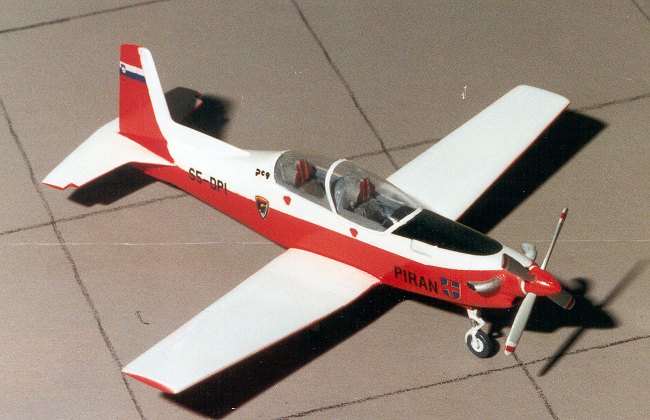
Aeroclub 1/72 Pilatus PC-9
Kit Number: ??
Price: $12.95
Decals : Three versions: Swiss and British demonstrators and Australian Air Force.

Comments: Those of you who built Aeroclub's PC-7 will be familiar with the PC-9. Both have the same faults and strengths, the difference being the PC-9 has no instrument panels, and a less interesting decal sheet.
This kit is typical of Aeroclub's early injected kits. The wings, tail and horizontal stab are one piece of plastic and molded well. The fuselage halves need a major rubdown to fit well and the interior is basic, although Aeroclub did include two very nice, but too tall, ejection seats. These seats and massive amounts of weight keep this one on its nose. Once the fuselage is completed and the nose intake filed to shape, it is time to hack on the fuselage to get the wing to fit. And I mean hack. A lot of plastic must be removed to get the wing in there flush and after that a mass of putty is required to smooth things out.
 Once the wing is in there and looks OK, it is time to work on the landing
gear. There is no nose well at all and the main gear well is not the proper
shape (it is the PC-7 wing, you know). To make things a bit more difficult,
there is no template for the PC-9s strangely curved main gear door. The canopy
is also a difficult to cut as the lines are near invisible. Careful attention
and fitting are required to get a good fit. Then it was time for the prop
and other small bits like antenna. Aeroclub's white metal propeller should
be replaced by a plastic one as my copy was badly pitted and too thick, just
like on the PC-7.
Once the wing is in there and looks OK, it is time to work on the landing
gear. There is no nose well at all and the main gear well is not the proper
shape (it is the PC-7 wing, you know). To make things a bit more difficult,
there is no template for the PC-9s strangely curved main gear door. The canopy
is also a difficult to cut as the lines are near invisible. Careful attention
and fitting are required to get a good fit. Then it was time for the prop
and other small bits like antenna. Aeroclub's white metal propeller should
be replaced by a plastic one as my copy was badly pitted and too thick, just
like on the PC-7.
However, it is the only PC-9 around and it does allow one to practice all those great modeling skills learned over the years. I bought the kit to use Blue Rider's Slovenian decal sheet and the final result looks acceptable. One big glitch on my part was the paint scheme. The decal sheet called the colors red-orange and white. I had no color photo of the plane so mixed what I thought was acceptable. As luck would have it, a week after finishing the kit, I saw a color photo and my shade is way too red. I also realize that I should have probably posed the blades feathered as is the norm for most small turboprops.
Recommended for those with experience in limited run kits and a high frustration threshold.
Kit built many, many years ago and availability is unknown.
Copyright ModelingMadness.com. All rights reserved. No reproduction in part or in whole without express permission from the editor.
Back to Reviews Page 2024